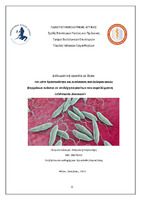In vitro δραστικότητα και αντίσταση αντιλεϊσμανιακών φαρμάκων ενάντια σε στελέχη παρασίτων του συμπλέγματος Leishmania donovani
In vitro determination of anti - leishmanial drug activity and resistance against Leishmania donovani strain complex

Λέξεις-κλειδιά
Παράσιτο ; Leishmania donovani ; Λεϊσμανίαση ; IC50 ; Αντιμόνιο ; Αμφοτερικίνη Β ; Real - Time PCR ; MRPA μεταφορέας ; H - locusΠερίληψη
Το γένος Leishmania (πρωτόζωο της οικογένειας Trypanosomatidae) περιλαμβάνει, μεταξύ άλλων, το κλινικά σημαντικό σύμπλεγμα L. donovani, το οποίο διακρίνεται σε 2 είδη, τα Leishmania (L.) donovani και L. infantum/L. chagasi (Παλαιός και Νέος Κόσμος αντίστοιχα), με το πρώτο να αποτελεί τον αιτιολογικό παράγοντα της VL και το δεύτερο να προκαλεί επιπλέον και την CL. Στην περιοχή της Ανατολικής Μεσογείου τα κρούσματα εντοπίζονται κυρίως σε σκύλους και δευτερευόντως στον άνθρωπο, ενώ η μετάδοση γίνεται μέσω σκνιπών του γένους Phlebotomus. Λόγω απουσίας εμβολίου, η ύπαρξη ποικιλίας θεραπευτικών επιλογών είναι καίριας σημασίας. Για την αντιμετώπιση της λεϊσμανίασης χρησιμοποιούνται κυρίως σκευάσματα βασισμένα στο πεντασθενές αντιμόνιο και η Αμφοτερικίνη Β, καθώς επίσης και ορισμένα άλλα φάρμακα, μεταξύ αυτών η μιλτεφοσίνη και η παραμομυκίνη. Παρόλα αυτά, ανησυχία προκαλεί το ότι έχει αρχίσει να παρατηρείται ανάπτυξη αντοχής, ιδίως σε όσα περιέχουν ενώσεις αντιμονίου. Έτσι, στην παρούσα εργασία αρχικά μελετήθηκε η ευαισθησία ή η αντοχή στο αντιμόνιο στελεχών που απομονώθηκαν από την Ελλάδα και την Τουρκία, μέσω υπολογισμού της τιμής IC50 χρησιμοποιώντας την μέθοδο αναγωγής της ρεσαζουρίνης, με 2 από τα 9 που δοκιμάστηκαν να εμφανίζουν IC50 μεγαλύτερο του ορίου ανθεκτικότητας. Παράλληλα, στα ίδια στελέχη χορηγήθηκε και AmpB, άλλο σημαντικό αντιλεϊσμανιακό φάρμακο έναντι του οποίου δεν έχει καταγραφεί ανάπτυξη αντοχής. Πράγματι, και τα 9 στελέχη χαρακτηρίστηκαν ως ευαίσθητα. Πολλοί μηχανισμοί ανάπτυξης αντοχής έχουν ήδη αποσαφηνιστεί και ένας από αυτούς περιλαμβάνει αύξηση της έκφρασης του MRPA μεταφορέα, μόριο που συμβάλλει στην απομάκρυνση του δραστικού αντιμονίου από το κύτταρο και κωδικοποιείται στον γονιδιακό τόπο H-locus, (χρωμόσωμα 23). Έτσι, το δεύτερο μέρος της έρευνας περιλαμβάνει την απομόνωση γενετικού υλικού και τον μοριακό έλεγχο 4 εκ των 9 στελεχών μέσω δοκιμασίας RT-PCR που αναπτύχθηκε στο εργαστήριο. Μέσω αυτής, ελέγχθηκε η έκφραση του κωδικοποιητικού γονιδίου του MRPA μεταφορέα σε σύγκριση με την έκφραση άλλου, σταθερά διπλοειδούς γονιδίου, συγκεκριμένα αυτού που κωδικοποιεί το ένζυμο G3PD και η ποσοτικοποίηση έγινε με την μαθηματική μέθοδο ΔΔCt, η οποία εν τέλει επιβεβαίωσε την ύπαρξη διπλάσιας ποσότητας του γονιδίου που κωδικοποιεί τον MRPA μεταφορέα στο ανθεκτικό στο αντιμόνιο στέλεχος συγκριτικά με ένα ευαίσθητο.
Περίληψη
The genus Leishmania (a protozoan of the Trypanosomatidae family) includes, among others, the clinically important L. donovani complex, which is divided into 2 species, Leishmania (L). donovani and L. infantum/L. chagasi (Old and New World respectively), with the former being the causative agent of visceral leishmaniasis and the latter also causing cutaneous leishmaniasis. In the Eastern Mediterranean area, the cases are found mainly in dogs and secondarily in humans, while the transmission is through sand flies of the genus Phlebotomus. In the absence of a vaccine, the existence of a variety of treatment options is of great importance. For the treatment of leishmaniasis, formulations based on pentavalent antimony and Amphotericin B are mainly used, as well as some other drugs, among them miltefosine and paramomycin. However, the fact that resistance has begun to develop is concerning, particularly to the drugs which contain antimony compounds. Thus, in the present diploma thesis, the susceptibility or resistance to antimony of strains isolated from Greece and Turkey was initially studied, by calculating the IC50 value using the resazurin reduction method, with 2 of the 9 tested showing IC50 greater than the resistance threshold. In parallel, the same strains were also given AmpB, another important anti-leishmanial drug against which the development of resistance is not very common. Indeed, all 9 strains were classified as susceptible. Many resistance mechanisms have already been elucidated and one of them involves an increase in the expression of the MRPA transporter, a molecule that contributes to the removal of active antimony from the cell and is encoded in the H-locus gene domain (chromosome 23). Thus, the second part of the research includes the isolation of genetic material and the molecular control of 4 of the 9 strains through a RT-PCR test developed in the laboratory. Through this, the expression of the coding gene of the MRPA transporter was compared to the expression of another, permanently diploid gene, the one encoding the G3PD enzyme in specific, and the quantification was done with the use of the mathematical method ΔΔCt, which confirmed the existence of a double amount of the gene encoding the MRPA transporter in the antimony-resistant strain compared to a susceptible one.

